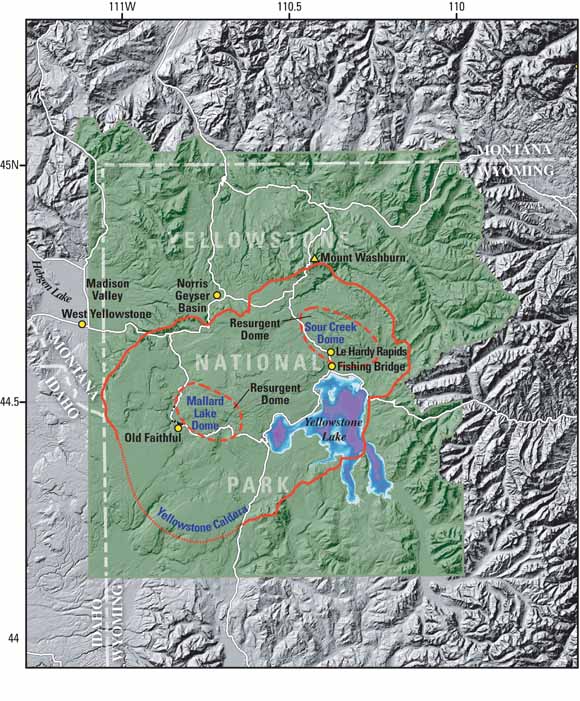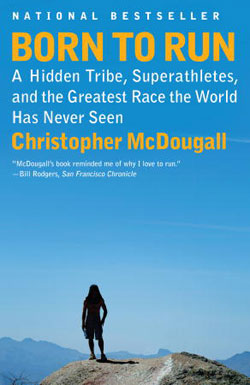Ashfall by Mike Mullin
Terre Haute, IN : Tanglewood, c2010.
466 p. ; 22 cm.
The picture at the top of this post should give you pause. Yellowstone Park [shaded in green], the US national treasure of hot springs, geysers, mountains, lakes and wildlife is basically the crater - or caldera [large red boundary] of an incredibly massive supervolcano that last had a major eruption about 640,000 years ago. Ok, 640,000 years ago is a long time, but the problem is that it will erupt again in the future - probably not in our lifetimes (but it could). It is the unlikely, but theoretically possible event of such a nation-shattering (about 2/3 of the US would be significantly damaged) and world-altering volcanic event that starts Mike Mullin's first novel off with a bang.
The novel is set far away (hundreds of miles) from Yellowstone, - in Iowa - but not far enough away to escape the devastating noise, ash and ejecta of the eruption. The event creates a cataclysmic environment through which the hero of the novel - 17 year old Alex - seeks to survive as he heads east toward Illinois where his family is. His ordeal through this landscape - one that brings to mind Cormac McCarthy's The Road - forms the plot of this thrilling novel.
As you might imagine this new, altered world brings out the best and definitely the worst in people and institutions that Alex is exposed to. A bright spot is his joining forces with a remarkable young woman, Darla, whose skills and courage help Alex survive. Not surprisingly the two eventually fall in love, in a rather believable, and touching way.
The novel should appeal to all kinds of readers. There is disaster, survival, action, romance, and some gritty violence and tragedy. I really appreciated how Mullin allows his novel to really delve into the complex ways that individuals and institutions can trend toward good - and definitely toward evil in situations of grave social disruption. I could easily recommend this book. We also recently acquired the sequel - Ashen Winter.
Tuesday, November 19, 2013
Ka-Boom!
Labels:
disaster,
eruption,
Illinois,
Iowa,
Mike Mullin,
romance,
supervolcano,
survival,
volcano,
z title: Ashfall
Friday, November 15, 2013
An Addictive Novel
Crank by Ellen Hopkins
New York : Simon Pulse, 2004.
537 p. ; 18 cm.
Hopkins manages to pull you into the mind and world of a high school-aged good kid drawn into a downward spiral due to her growing addiction to methamphetamine (crank). She does it with really nice verse that allows her to often have the main character's thoughts, spoken words, and dialogue from others all in one poem.
This book, and many of Hopkins very long novels in verse are very popular and I can see why. Her strength is that she deals honestly with the appeal of drug abuse - while at the same time illuminating the horrors and dangers of addiction. It's a skillful balancing act that keeps her book compelling but not preachy. Also the variety of poetic line structures works pretty well - allowing calm meditative poems, jumbled high-on-meth poems, broken blocks of verse to reflect multiple voices and perspectives, etc.
In a short "Author's note" at the beginning of the book, Hopkins reveals that much of the substance of her novel in verse is from her own life as a mother with a meth-addicted daughter, though she admits that many events, characters, etc. are composites based on real life experiences.
No need to recommend this book, as it remains very popular. I'm glad I finally got around to reading it, so I can appreciate its many strengths.
New York : Simon Pulse, 2004.
537 p. ; 18 cm.
Hopkins manages to pull you into the mind and world of a high school-aged good kid drawn into a downward spiral due to her growing addiction to methamphetamine (crank). She does it with really nice verse that allows her to often have the main character's thoughts, spoken words, and dialogue from others all in one poem.
This book, and many of Hopkins very long novels in verse are very popular and I can see why. Her strength is that she deals honestly with the appeal of drug abuse - while at the same time illuminating the horrors and dangers of addiction. It's a skillful balancing act that keeps her book compelling but not preachy. Also the variety of poetic line structures works pretty well - allowing calm meditative poems, jumbled high-on-meth poems, broken blocks of verse to reflect multiple voices and perspectives, etc.
In a short "Author's note" at the beginning of the book, Hopkins reveals that much of the substance of her novel in verse is from her own life as a mother with a meth-addicted daughter, though she admits that many events, characters, etc. are composites based on real life experiences.
No need to recommend this book, as it remains very popular. I'm glad I finally got around to reading it, so I can appreciate its many strengths.
Thursday, November 14, 2013
Hi Tech Guilt
 |
| A version of Think Tank 1's cover from the Top Cow Website |
Los Angeles : Top Cow Productions, Inc., 2013
1 v. (unpaged) : chiefly ill. ; 26 cm.
David Loren has a guilty conscience. He is the main character of this new graphic novel series from Matt Hawkins and Rashan Ekedal, and he's begun to question his role as a super-intelligent weapons developer for a Pentagon think tank that recruited him with a full scholarship to Cal Tech when he was just 14.
In the 10 years since that time he has begun to question the value of what he is doing (reflecting on the human toll that his lethal creations have) and he wants out. Unfortunately for David, he's pretty much a prisoner on the high-security base where he lives and works. But given his technical wizardry, he decides he's going to escape - one way or another.
The story is fast-paced, exciting, interesting and ends with a dramatic twist that sets the reader up for the next installment of Think Tank. Not bad for a debut graphic novel.
I really appreciated the author's scientific and ethical depth. The novel ends with a section that explains some of the terms and references found in the story (e.g. DARPA, Einstein quotes, etc.) and contains references to some of the real-world hi-tech weaponry currently being developed by the Pentagon and its private contractors. A good read for the tech-savvy, current-events aware fan of graphic novels.
For more insight into Think Tank take a look at this interview with Matt Hawkins, or this review of Think Tank 1.
Monday, November 4, 2013
Homo Cursorius
Born to Run: a Hidden Tribe, Superathletes, and the Greatest Race the World Has Never Seen by Christopher McDougall
New York : Vintage Books, 2011, c2009.
1st Vintage Books ed.
287 p. ; 21 cm.
For the past couple of months my son has been insisting that I had to read Born to Run - so I did. He was right; it was a great read! Not perfect, but pretty amazing!
The book is an exuberant introduction to the phenomena of ultrarunning, but it is more than that. It is a celebration of human running, of adventure and determination, and the amazing - and often larger than life - personalities of ultrarunners. Even more, the book serves as a provocative look at human origins, evolution and the possibility that modern humans (all of us!) are born with the capacity to run far longer and farther than most of us have ever run - and to do it with minimal injuries. This last aspect has McDougall casting a rather critical eye on the whole modern running shoe industry.
McDougall's hook for the book is his search for the enigmatic indigenous people of Northwest Mexico, the Tarahumara who survived contact with the Spaniards by avoiding engagement with them, opting instead to live in the very sparse, barren, and rugged terrain of the Copper Canyon in Mexico. The Tarahumara also happen to be world class endurance runners, and McDougall's renewed interest in long distance running (which had hobbled him with injuries) is rekindled during his successful search for the Tarahumara. His contact person, almost-mythical gringo runner and hermit called el Caballo, draws McDougall into his wildly ambitious plans to stage a race in the dangerous Copper Canyon pitting the greatest ultrarunners from North America against the greatest Tarahumara runners. As you can imagine, the outcome is hair-raising and almost unbelievable.
I have to admit that when I first began reading the book, I was a bit put off by McDougall's overblown style and descriptions - every character is the most amazing, most awesome, most eccentric, most etc. etc., that one could imagine. However, on Googling some of the characters in the book, they have in fact accomplished ridiculously grueling feats of running endurance - and often faster and more energetically than any other humans on the planet. My only other complaint is that the book would have been much better with at least some photos - particularly of the characters who populate the book.
This book will definitely have you thinking a lot about running, whether you are someone who has never run before or are a seasoned marathoner. And it does it with fun, adventure and a true zest for the subject. Not bad for a book on something as common as running from here to there!
New York : Vintage Books, 2011, c2009.
1st Vintage Books ed.
287 p. ; 21 cm.
For the past couple of months my son has been insisting that I had to read Born to Run - so I did. He was right; it was a great read! Not perfect, but pretty amazing!
The book is an exuberant introduction to the phenomena of ultrarunning, but it is more than that. It is a celebration of human running, of adventure and determination, and the amazing - and often larger than life - personalities of ultrarunners. Even more, the book serves as a provocative look at human origins, evolution and the possibility that modern humans (all of us!) are born with the capacity to run far longer and farther than most of us have ever run - and to do it with minimal injuries. This last aspect has McDougall casting a rather critical eye on the whole modern running shoe industry.
McDougall's hook for the book is his search for the enigmatic indigenous people of Northwest Mexico, the Tarahumara who survived contact with the Spaniards by avoiding engagement with them, opting instead to live in the very sparse, barren, and rugged terrain of the Copper Canyon in Mexico. The Tarahumara also happen to be world class endurance runners, and McDougall's renewed interest in long distance running (which had hobbled him with injuries) is rekindled during his successful search for the Tarahumara. His contact person, almost-mythical gringo runner and hermit called el Caballo, draws McDougall into his wildly ambitious plans to stage a race in the dangerous Copper Canyon pitting the greatest ultrarunners from North America against the greatest Tarahumara runners. As you can imagine, the outcome is hair-raising and almost unbelievable.
I have to admit that when I first began reading the book, I was a bit put off by McDougall's overblown style and descriptions - every character is the most amazing, most awesome, most eccentric, most etc. etc., that one could imagine. However, on Googling some of the characters in the book, they have in fact accomplished ridiculously grueling feats of running endurance - and often faster and more energetically than any other humans on the planet. My only other complaint is that the book would have been much better with at least some photos - particularly of the characters who populate the book.
This book will definitely have you thinking a lot about running, whether you are someone who has never run before or are a seasoned marathoner. And it does it with fun, adventure and a true zest for the subject. Not bad for a book on something as common as running from here to there!
Subscribe to:
Posts (Atom)



